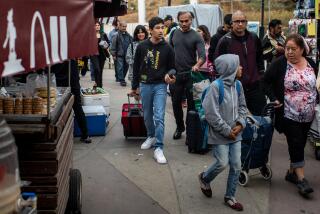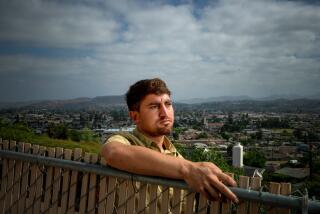Asylum-Seeker Feels Like ‘Slave’ in U.S. Detention
- Share via
Pramjit Singh says he was running for his life. He boarded a flight for Los Angeles--and federal detention.
“Here, I feel I’m living as a slave,” Singh, who was a farmer from India’s troubled Punjab state, said in an interview at the U.S. Immigration and Naturalization Service lockup on Terminal Island, where he has been held since his arrival at Los Angeles International Airport in April from New Delhi.
Singh, whose broad beard and flowing mane attest to his Sikh faith and its prohibition on cutting hair, is one of the 12,000-15,000 asylum-seekers annually disembarking at U.S. airports, authorities say. They leave repressive regimes from China to Somalia.
In Singh’s case, he says he was the victim of torture and threats from Indian authorities, who, according to human rights monitors, have violently repressed Sikh nationalists.
The airport arrivals figure prominently in the heated national debate concerning the beleaguered asylum program, now facing likely congressional overhaul.
Airport claimants represent a minority of the more than 120,000 foreigners expected to file asylum applications this year. Most asylum-seekers are residing in the United States, usually having entered illegally via the U.S.-Mexico border or legitimately with short-term visas.
Yet the airport asylum arrivals have assumed a disproportionate role in the debate, largely because of fears that terrorists making bogus asylum claims favor the airport route. Immigrant advocates dismiss the link as spurious.
In 1991, immigration authorities concerned about bogus asylum applicants disembarking at LAX began detaining most airport claimants. Some remain locked up for a year or more as their cases drag on. After the detention order, asylum applicants at the airport plummeted from more than 1,000 per month to fewer than 100 monthly.
Authorities say smugglers directing the thriving traffic in bogus asylum claimants soon shifted to New York’s John F. Kennedy International Airport, where, because of a lack of detention space, most asylum applicants are released. Many skip asylum hearings, disappearing into the thriving immigrant labor market.
Singh and his attorney, Helen A. Sklar, say the Sikh activist is a legitimate refugee wrongly imprisoned and legitimately fearing for his life if forced back to India.
His eyes welling with tears, Singh said: “I always thought that whosoever stepped foot in America, their lives would be saved.”
More to Read
Sign up for Essential California
The most important California stories and recommendations in your inbox every morning.
You may occasionally receive promotional content from the Los Angeles Times.









